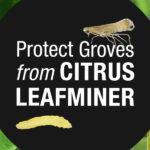What’s in a Branded Crop Protection Product?
Active ingredients work with other components for effective crop protection.

Growers choose crop protection inputs with one goal: to protect their investment. When generic inputs fail to reduce weed pressure, prevent disease or deter pests, growers are left with decreased yield potential and questions about what went wrong. Often, the blame is directed toward the generic product’s active ingredients, but they are not the sole indicators of an effective product. Other ingredients play a critical role in the form of branded crop protection inputs, and they set branded products apart from generic ones.
According to Jeremy Fowler, Ph.D., group leader of formulation development at Syngenta, two significant differentiators between Syngenta products and generics often are the complexity of formulations with carefully balanced inert ingredients and the investments in research to back them up.
Active Ingredients Are Not Alone
Syngenta products contain a precise blend of active ingredients and additional components that may give Syngenta products an edge. “The number of formulation ingredients besides the active ingredients gives a more sophisticated formulation package that’s designed to not only give you robustness in the final product itself, but stability over a wide range of conditions,” Fowler says.
These components contain anything from stabilizers for solid particles, emulsifiers for oily droplets and pH buffering systems to more mundane ingredients like antifoam and antifreeze. The addition of the components and their specific ratios depends on the individual active ingredients in each product. The precise blends that result provide the reliability, efficacy and flexibility traits growers have come to expect from Syngenta products. The complex formulations also address many of the complaints growers have about generic products, from problems with spray application to flow rate and beyond.
“All of these ingredients have a particular role to play, depending on where they’re introduced,” says Fowler. “The tricky part, and where generics may not have the time investment or the scientific staff to ensure robustness, is to make sure that across all of those ingredients, they’re all compatible in the formulated product.” After all, he adds, growers can’t afford surprises.
All of these ingredients have a particular role to play, depending on where they’re introduced. The tricky part, and where generics may not have the time investment or the scientific staff to ensure robustness, is to make sure that across all of those ingredients, they’re all compatible in the formulated product.
Research-Backed Formulations Deliver Results
Finding the perfect balance for these complex formulations takes an unmatched investment in time and scientific staffing. Generics typically go to market faster with less complex formulations. In contrast, the average timeline for a Syngenta product is extended to allow plenty of time for development, evaluation and optimization by a global team of scientists.
“We’ll spend a minimum of about two years making sure that we want to continue progressing each product,” says Fowler. “The longer timeline for development allows us to spend more time doing more experiments, refining stability criteria and checking a wide range of different conditions over an extended period of time.”
The additional time spent optimizing products takes the guesswork out of application and ensures product performance meets a high standard. The entire Syngenta network of agronomists and scientists is confident in the science behind the products. When growers choose a Syngenta product, they know exactly what to expect.
When it comes to generic products, not only is there often a lack of comparable supportive research, but growers also typically may be on their own when problems arise. Syngenta customers, on the other hand, have a global team of industry leaders to turn to.
“We can pull global expertise and respond directly to suppliers and distributors, all the way to the grower level to ensure that their experience is the best they can get,” says Fowler. In addition to the formulations and additional components themselves, this level of support is the key differentiator between Syngenta products and generics.
Trust the Experts
Growers who don’t have a firm grasp of the role of other product ingredients may be tempted to choose generic products or even try to mix their own. Fowler warns that playing the role of a chemist can have severe unforeseen consequences.
“If you’re killing weeds or a fungal infection in your field, the active ingredients are really powerful,” he says. “They have to be introduced at the right time under the right conditions. We have the expertise to ensure that it goes well. When you start doing the chemistry part on your own, you can deviate into crop injury and other impacts that we would hope everyone could avoid.”
Getting the interactions between chemicals wrong might mean damaging crops to the point that their value is diminished or gone for the season. Even partial crop injury can cause a reduction in yield and, therefore, in profit — leaving growers in a worse position overall.
All companies provide label information to mitigate these risks, but crop injury and subpar results can still happen. One challenge occurs when similar products adopt comparable language despite discrepancies in the formulation technology. There might be assumptions built into the language of generic products that overstate the performance and predictability of the formulations. For that reason, Fowler explains, growers need to seriously examine the reliability of the information provided by the manufacturer in addition to the products themselves.
It comes back to the research investment that Syngenta makes in each of its products. “We invest the time to make sure that the recommendation we’re providing has been validated over and over at numerous levels,” he says. “If another company is not investing that time, your odds start to go up that they’ve missed something.”
The most reliable sources of product information are companies with transparent trial data. Growers can learn more about product formulations by checking out trial data and Syngenta Grow More™ Experience sites.
“We have agronomy experts to talk with customers about exactly what we did and what conditions we did it in,” Fowler explains. “You can see a real plot where it’s applied; and to me, that’s irrefutable.”
Chemicals for Purpose, Not Filler
It is vitally important for growers to realize that the additional components in branded products are not simply fillers. It’s easy to take certain ingredients, like antifreeze, for granted until a problem occurs and growers realize the importance of predictable freezing and thawing behavior too late. Other components like surfactants might be unrecognizable to many growers; but to Syngenta scientists, they represent the result of a complex selection process to maintain microstructure and stability.
Ultimately, for Fowler, the proof that the brand matters is present in the marketplace as well as in the lab. “Growers have relied on many of our products for years,” he says. “That just shows that attention to detail upfront gives you something with a lot of longevity at the end.”
4 Min Read
- Two key differentiators between Syngenta products and generics may include the complexity of formulations and investment in research.
- Syngenta is comprised of a global network of scientists who collaborate to deliver effective product formulations.
- Inactive ingredients play an important role in reliable and effective formulations.























